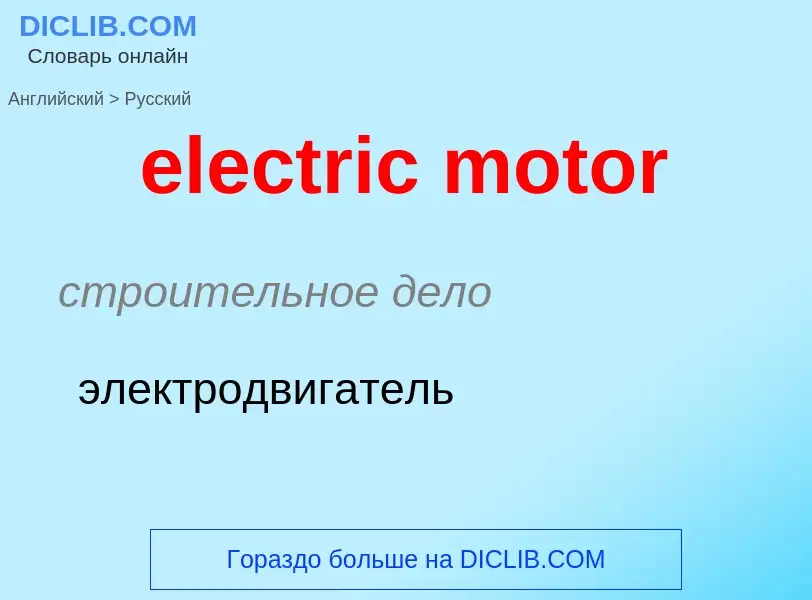Перевод и анализ слов искусственным интеллектом ChatGPT
На этой странице Вы можете получить подробный анализ слова или словосочетания, произведенный с помощью лучшей на сегодняшний день технологии искусственного интеллекта:
- как употребляется слово
- частота употребления
- используется оно чаще в устной или письменной речи
- варианты перевода слова
- примеры употребления (несколько фраз с переводом)
- этимология
electric motor - перевод на русский
строительное дело
электродвигатель
[ilektrə'məutə]
общая лексика
электромотор
существительное
общая лексика
электродвигатель
электромотор
электрический двигатель
['kɔ:lis]
общая лексика
бесстержневой
без сердечника
Смотрите также
прилагательное
общая лексика
без сердцевины
полый
электротехника
без сердечника
общая лексика
редукторный электродвигатель
общая лексика
асинхронный электродвигатель
['məutəvi:ik(ə)l]
общая лексика
механическое транспортное средство
автомобиль
автомашина
['məutəʃip]
общая лексика
теплоход
1) pl автомобили
2) автомобильная промышленность
Определение
Википедия

An electric motor is an electrical machine that converts electrical energy into mechanical energy. Most electric motors operate through the interaction between the motor's magnetic field and electric current in a wire winding to generate force in the form of torque applied on the motor's shaft. An electric generator is mechanically identical to an electric motor, but operates with a reversed flow of power, converting mechanical energy into electrical energy.
Electric motors can be powered by direct current (DC) sources, such as from batteries, or rectifiers, or by alternating current (AC) sources, such as a power grid, inverters or electrical generators.
Electric motors may be classified by considerations such as power source type, construction, application and type of motion output. They can be powered by AC or DC, be brushed or brushless, single-phase, two-phase, or three-phase, axial or radial flux, and may be air-cooled or liquid-cooled.
Standardized motors provide convenient mechanical power for industrial use. The largest are used for ship propulsion, pipeline compression and pumped-storage applications with output exceeding 100 megawatts.
Applications include industrial fans, blowers and pumps, machine tools, household appliances, power tools, vehicles, and disk drives. Small motors may be found in electric watches. In certain applications, such as in regenerative braking with traction motors, electric motors can be used in reverse as generators to recover energy that might otherwise be lost as heat and friction.
Electric motors produce linear or rotary force (torque) intended to propel some external mechanism, such as a fan or an elevator. An electric motor is generally designed for continuous rotation, or for linear movement over a significant distance compared to its size. Magnetic solenoids are also transducers that convert electrical power to mechanical motion, but can produce motion over only a limited distance.








![Tesla Museum]] in Belgrade, Serbia Tesla Museum]] in Belgrade, Serbia](https://commons.wikimedia.org/wiki/Special:FilePath/Tesla's induction motor.jpg?width=200)



![plug-in passenger cars]] in the world's top markets between 2011 and 2021 plug-in passenger cars]] in the world's top markets between 2011 and 2021](https://commons.wikimedia.org/wiki/Special:FilePath/Global plug-in car sales since 2011.png?width=200)

![Historical evolution of the Norwegian [[plug-in electric car]] segment [[market share]] of new car sales and monthly records between 2011 and 2021. Sources: Norwegian Road Federation (OFV) and Norsk Elbilforening (Norwegian EV Association) Historical evolution of the Norwegian [[plug-in electric car]] segment [[market share]] of new car sales and monthly records between 2011 and 2021. Sources: Norwegian Road Federation (OFV) and Norsk Elbilforening (Norwegian EV Association)](https://commons.wikimedia.org/wiki/Special:FilePath/Norway PEV market share since 2011.png?width=200)

![Electric bicycles parked in [[Yangzhou]]'s main street, Wenchang Lu. They are a very common way of transport in this city, in some areas almost outnumbering regular bicycles. Electric bicycles parked in [[Yangzhou]]'s main street, Wenchang Lu. They are a very common way of transport in this city, in some areas almost outnumbering regular bicycles.](https://commons.wikimedia.org/wiki/Special:FilePath/Yangzhou-WenchangLu-electric-bicycles-3278.jpg?width=200)
 200601.jpg?width=200)
![Cruise ships on the [[Volga River]], [[Russia]] Cruise ships on the [[Volga River]], [[Russia]]](https://commons.wikimedia.org/wiki/Special:FilePath/Круизные корабли на Волге.jpg?width=200)
